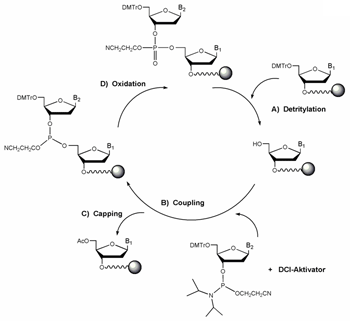We are using different synthesis machines with phosphoramidite chemistry (Caruthers, M.H. (1983) Tetrahedron Lett. 24:245-248).
The oligonucleotides are synthesised in 3' to 5' direction while attached covalently to a solid support (solid phase synthesis).The building blocks used for synthesis are DNA phosphoramidite nucleosides which are modified with different protection groups.

Synthesis starts with de-blocking (A) i.e. the cleavage of the 5' protection group dimethoxytrityl (DMT).
An activated phosphoramidite nucleoside couples with the free 5' hydroxyl function (B). Typically coupling efficiency is between 98% and 99.5%. Since the coupling efficiency is not 100%, a small percentage of truncated sequences is produced at every coupling step. If these failure sequences are allowed to further react, unwanted mutants would result.
This problem is overcome largely by capping the remaining free 5' hydroxyls through acetylation (C). Some molecules fail to cap and continue to participate in additional synthesis cycles, resulting in nearly full length molecules that contain internal deletions - the so-called (n-x) mer species.
After coupling, the DNA bases are connected by an unstable phosphite triester. It is converted to a stable phosphotriester linkage by oxidation (D). The oxidation step completes one cycle of oligo synthesis. DNA synthesis can continue with the removal of the DMT group at the 5' -end of the growing chain, starting another cycle of nucleotide addition.
Oligonucleotide cleavage from support and deprotection is achieved under alkaline conditions.